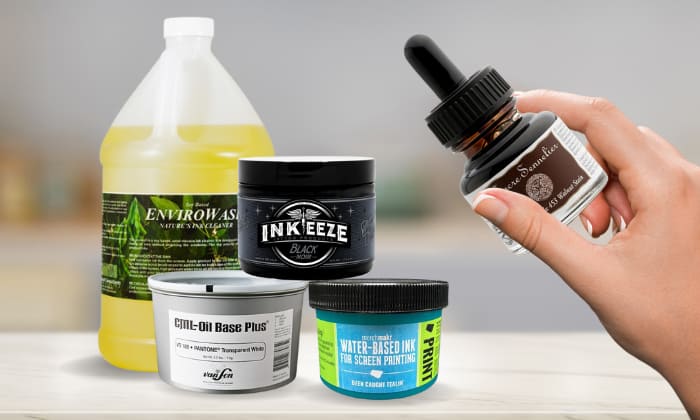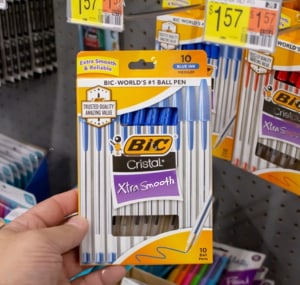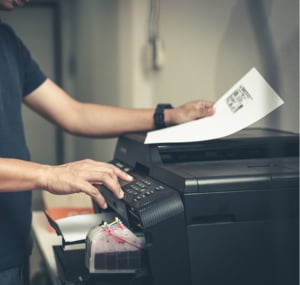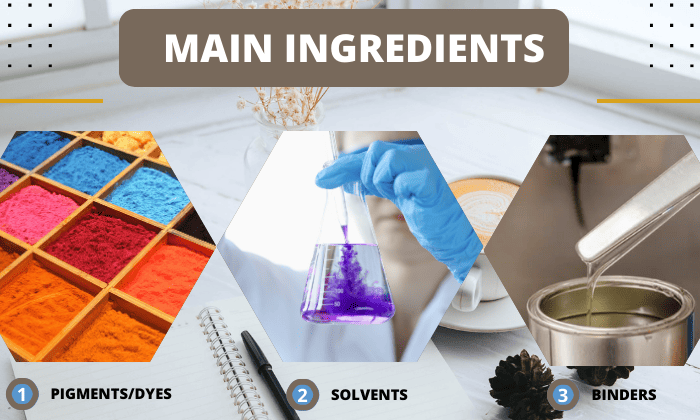What is pen ink made of originally? Carbon particles for pigment and vegetable oil or animal glue as a carrier were most likely used in these early inks. It was the ancient Chinese and Egyptians who invented and developed them.
But what is pen ink made of today? Well, it is still formulated using time-tested methods. It is composed of dyes or pigments, stabilizing polymers, and solvents. Some contain additives such as glycerides, triethanolamine, or clay.
However, there are several types of pen ink – oil-based, petroleum-based, soy-based, shellac-based, and water-based. Let’s talk about each of them!
Table of Contents
Types of Pen Ink
1. Oil-based ink
- Origin
It was in 1938 when László Bíró invented the first modernized ballpoint pen that utilized dyes and oil-based ink, which dried quickly and rendered a smooth writing experience.
- Characteristics and applications
Characterized by their thickness and sludgy texture, oil-based ink is often referred to as ballpoint pen ink. Since it writes permanently without fading too quickly, oil-based ink has been a popular option for glossy or rough paper types.
The Bic Cristal ballpoint pen is one of the best examples of oil-based ink pens. It uses a special oil-based Bic pen ink that writes smoothly and fast on a vast array of surfaces. It is also water-resistant.
- Pros and cons
Despite the impeccable longevity and quick-drying feature of oil-based inks, they sometimes fall short of consistent ink flow, depending on the ballpoint sizes. Typically, ballpoint pens with larger widths do not dispense oil-based ink smoothly, resulting in uneven strokes and lines.
- Convenient to use
- Long-lasting and consistent ink quality
- Quick-drying
- Can write on different types of paper
- Available in a variety of colors
- Commonly used in ballpoint pens
- Restricted ink flow may result in streaky or skippy lines, especially in wider ballpoints
2. Petroleum-based ink
- Origin
Petroleum-based inks were commonly used for printing newspapers because they dry fast, not to mention the cost-effective formula. FIY, petroleum-based inks were developed as an alternative to vegetable oils back in the 1960s.
- Characteristics and applications
The salient characteristics as well as the chemical formula of petroleum-based ink are marked by a heightened concentration of refined petroleum. Aside from that, it contains a profusion of VOCs (volatile organic compounds), which include xylene, toluene, and benzene.
Moreover, petroleum-based inks highlight their binding properties that produce durable ink quality, pigmented colors, and glossy finishes. For that reason, this ink type is widely utilized for printing.
- Pros and cons
One potential disadvantage of petroleum-based inks is their impact on air quality and human health. The emanation of VOCs that ensues during a printing or writing process might cause respiratory issues and exacerbate air pollution.
- Cost-effective
- Provides smooth and glossy finishes
- Presents pigmented and durable color quality
- Quick-drying
- Commonly used in the printing industry
- Not eco-friendly
3. Water-based ink
- Origin
Although it is unclear when water-based inks were first used, this ink formulation is commonly found in fountain pens, which are popular common writing implements that were invented in 1827.
- Characteristics and applications
Also referred to as water ink pens, water-based ink is the prominent component of fountain pen ink formulations. Typically combined with dyes, water-based inks provide smooth ink flow and vibrant colors.
Besides that, gel pen ink elements and rollerball inks include water-based pen ink ingredients that are ideal for everyday writing, drawing, and various writing activities. Similarly, gel pens deliver consistent ink flow and pigmented hues.
- Pros and cons
The common downsides of water-based ballpen inks include long drying time, smudging, streaky applications, and the inability to be blended easily.
- Writes smoothly
- Versatile and available in a wide variety of colors
- Suitable for high-speed roll-to-roll yardage printing
- Commonly used in fountain pens and rollerball pens
- Impressive water resistance and permanence
- Slow drying time
- Streaky and easily smudges
4. Soy-based ink
- Origin
Because of the oil crisis in the late 1970s, the printing businesses ventured into a new ink type, which is soy-based ink, for a cheaper, more environmentally friendly, and more efficient method in lieu of petroleum-based inks.
- Characteristics and applications
Soy-based ink is made from soybeans, where the soy oil is refined and mixed with resins and waxes to create an inky texture. The use of soy-based ink is considered an environmentally friendly ink compared to petroleum or oil-based inks as it is derived from a sustainable source.
The main characteristic of soy ink is its ability to produce vibrant colors, primarily because it is clean and less oily.
Moreover, it is widely used in a broad variety of printing applications, including commercial printing, packaging, and paper products. It is also compatible with different printing methods like offset and flexographic printing.
Take note that this eco-friendly ink has a slower drying time, however, can be an advantage in certain printing applications that require precise color reproduction.
- Pros and cons
The slow drying time of soy-based ink, however, may somehow be a disadvantage to some users. Since it may result in longer printing and drying times, it may not be ideal for fast-paced printing environments and other tasks that need quick turnaround time.
- Environmentally friendly; made from a sustainable source
- Produces bright and vibrant colors
- Suitable for printing on various paper types
- Compatible with different printing methods
- More affordable compared to other oil or petroleum-based inks
- Slow drying time
5. Shellac-based ink
- Origin
Shellac-based pen ink is derived from shellac, a natural resin that is secreted by the lac insect and harvested from tree trunks in Asia.
Because of their vivid hues and satin finish, shellac-based inks have been an excellent option for furniture varnish and painting over the years. It is also the main ingredient in Sennelier inks.
- Characteristics and applications
The depth, dark color, and longevity of shellac-based ink are what make it special. It makes bold and powerful lines on paper and is frequently waterproof and lightfast, which means it will not fade over time.
Shellac-based ink is commonly used in calligraphy, art, and for writing purposes that require durability and longevity such as archival documents. It is typically used in dip pens or other writing instruments that can be easily cleaned with acetone.
- Pros and cons
As shellac resin tends to dry and harden, ink may not flow smoothly in fountain pens or rollerball pens and may even result in ink clogging.
- Dense and dark color for intense marks
- Waterproof and lightfast
- Suitable for art, calligraphy, and archival writing purposes
- Provides a glossy finish when dry
- Can be used as a sealing finish on wood or other porous substrates
- Can clog fountain pens or rollerballs
Is Pen Ink Toxic or Not?
Pen ink is generally considered to be non-toxic and safe for daily use.
Ingesting a small amount of ink from pens, markers, or highlighters is unlikely to cause ink poisoning or serious harm. The main components of pen ink, such as water, solvents, and dyes, are generally not toxic.
However, ingesting a large amount of ink or constantly inhaling ink fumes, especially petroleum-based ink, can potentially cause mild stomach upset or respiratory issues. It is always best to avoid ingesting or inhaling ink.
How is Pen Ink Made?
Ink is a writing medium that has been used for centuries, with its origins traced back to ancient civilizations. Where does ink come from? The modern inks used today usually contain a combination of ingredients:
- Pigments/Dyes. The pigments or dyes are selected according to the chosen color or lightfastness. They are insoluble solids that are ground into an extremely fine powder, whereas dyes are soluble liquids.
- Solvents. Water and alcohol are classic examples of solvents. They are usually mixed with pigments or dyes to produce a liquid-based colorant.
- Binders. The binders help the colorant adhere to the surface on where the ink will be written or drawn. They also help in preventing smudges. The most common example of binders is resins.
These three main ingredients are then mixed together. If the ink mixture is not yet smooth-flowing, certain additives such as glycerides may be added to the formulation to improve ink flow.
After that, a final test will be conducted. Once the pen ink’s color, viscosity, flow, and drying time passed the quality standards of the manufacturer, then it will be good to go.
Frequently Asked Questions
What are the components of erasable ink?
The components of erasable pen ink typically include thermoplastic elastomer, plasticizer, and solvent, which allow the ink to be removed using a conventional pencil eraser.
What is inside a blue ballpoint pen ink?
The blue pen ink used in ballpoint pens primarily contains synthetic blue dyes, benzyl alcohol for the dye to write or draw effectively, surfactants to help the ink adhere to the paper, and oleic acid to ensure smooth ink flow.
Is invisible ink permanent?
Yes. The invisible ink that is normally used in an invisible ink pen is permanent and can be used on various surfaces, even glass and plastics.
Can you use squid ink as pen ink?
Some of the earliest pens came from squid ink, but modern pen designs do not usually use squid ink. Pen ink today generally uses advanced formulation, and that does not include squid ink.
Conclusion
What is pen ink made of? In a nutshell, pen ink was traditionally made from carbon particles for pigment and vegetable oil or animal glue as a carrier. But today, pen inks are formulated using dyes or pigments, stabilizing polymers, liquid solvents, and other additives.
Different types of pen inks include oil-based, petroleum-based, soy-based, shellac-based, and water-based inks, each with its own pros and cons.

Art has always been a part of my life; it influences my upbringing and later my career choice. For me, it is always a part of my parenting technique. So for whichever purpose that you come to art, you can start here with us.









